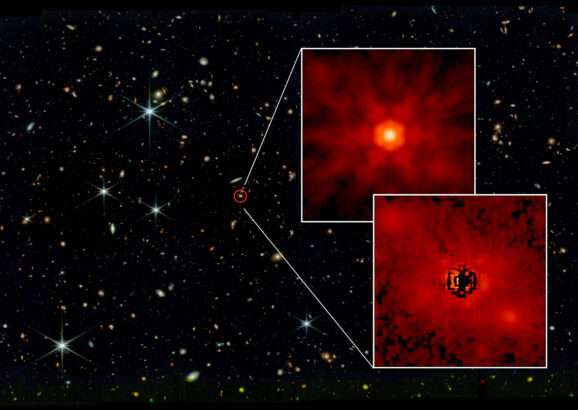Anna-Christina Eilers
Research Interests
Professor Anna-Christina Eilers is an observational astrophysicists leading the Cosmic Dawn Group at MIT. Her research focuses on the formation of the first galaxies, quasars and supermassive black holes in the early universe, during an era known as the Cosmic Dawn. In particular, Eilers is interested in the growth of the first supermassive black holes which reside in the center of luminous, distant galaxies known as quasars, to understand how black holes evolve from small stellar remnants to billion solar mass black holes within very short amounts of cosmic time. In her research, Eilers develops new methods to study the timescales of quasar activity and supermassive black hole growth phases. She aims to understand how galaxies and their central supermassive black holes evolve through cosmic time, how the accretion physics might change in the early universe, and what the origins of these early massive black holes are.
She uses a combination of multi-wavelength observations from telescopes around the world and in space, cosmological simulations, and new machine learning models. She is heavily involved in multiple programs using NASA’s James Webb Space Telescope, which is piercing deeper than ever before into the distant past of our universe. Eilers is also passionate about making science more accessible through public outreach.
Biographical Sketch
Anna-Christina Eilers is originally from San Francisco, California, but grew up in Germany. She received a Bachelor’s degree in Physics from the University of Goettingen with a focus on neuroscience. After an internship at the European Space Agency in The Netherlands she decided to study astrophysics at the University of Heidelberg, where she obtained her Master’s degree and completed her PhD at the Max Planck Institute for Astronomy in Heidelberg. During her thesis she worked with Prof. Joe Hennawi and Prof. Hans-Walter Rix on both high-redshift quasars and the early growth phases of supermassive black holes, as well as on data-driven models of stars within our own Galaxy, the Milky Way. In 2019 she was awarded a NASA Hubble Fellowship and the Pappalardo Fellowship to continue her research at MIT. In July 2023 she joined MIT’s Physics faculty as an assistant professor.

MIT astronomers observe elusive stellar light surrounding ancient quasars
The observations suggest some of earliest “monster” black holes grew from massive cosmic seeds.
Awards & Honors
- 2025 // Ludwig Biermann Award, German Astronomical Society
- 2023 // Otto Haxel Prize for Physics
- 2020 // Otto Hahn Medal, Max Planck Society
- 2020 // IAU PhD Prize, International Astronomical Union
- 2020 // Doctoral Thesis Award, German Astronomical Society
- 2019 // NASA Hubble Fellowship
- 2019 // MIT Pappalardo Fellowship
Key Publications
-
Eilers et al. 2024, The Astrophysical Journal: EIGER. VI. The Correlation Function, Host Halo Mass, and Duty Cycle of Luminous Quasars at z ≳ 6, https://iopscience.iop.org/article/10.3847/1538-4357/ad778b
-
Yue, Eilers et al. 2024, The Astrophysical Journal: Stacking X-Ray Observations of “Little Red Dots”: Implications for Their Active Galactic Nucleus Properties, https://iopscience.iop.org/article/10.3847/2041-8213/ad7eba
-
Durovcikova, Eilers et al. 2024, The Astrophysical Journal: Chronicling the Reionization History at 6 ≲ z ≲ 7 with Emergent Quasar Damping Wings , https://iopscience.iop.org/article/10.3847/1538-4357/ad4888
-
Yue, Eilers et al. 2024, The Astrophysical Journal: EIGER. V. Characterizing the Host Galaxies of Luminous Quasars at z ≳ 6, https://iopscience.iop.org/article/10.3847/1538-4357/ad3914
